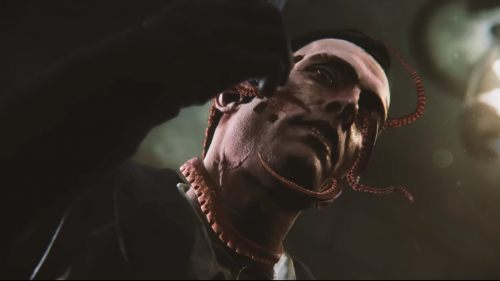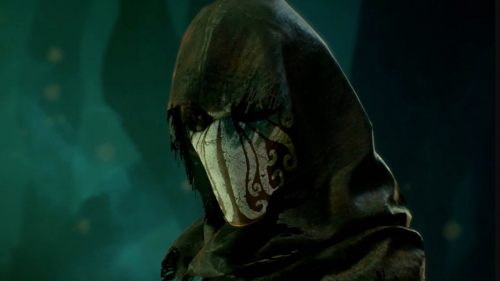CALL OF CTHULHU Game Review: He Points, You Click
“Enter Madness,” Call of Cthulhu’s main menu instructs. Cyanide Studio doesn’t mince words with its goals for the new video game adaptation of the HP Lovecraft short story. Can a new, traditionalist take on one of the most influential horror universes of all time bring the creepy goods? Can it make players, as it aims to, enter madness?
Edward Pierce, a WWI vet and private detective looking for all the world like John Constantine, is a drearily typical video game protagonist. Gruff and gravelly, inclined towards misery, alcohol, and sleeping pills, he works out of an office that could be interchanged with those of LA Noire’s Cole Phelps or Bioshock Infinite's Booker DeWitt, if you changed the name on the door. In a way, though, this cookie-cutter meat-slab is the perfect type to put through a Lovecraftian mental wringer. From the moment he wakes up in a mound of shark carcasses and whale entrails, it’s a delight to submit Mr Pierce (he even has the same surname as Watch Dogs’ Aidan!) to cosmic mental agony.
The story kicks off with the investigation of a house fire, allegedly caused by its allegedly-mad artist inhabitant. This being a Lovecraft adaptation, she both is and isn’t; the madness that has stricken the island and former whaling community of Darkwater has roots that go very deep. The story quickly turns even darker, involving the usual Lovecraftian cults, medical experiments, nightmares, conspiracies, the horror of knowledge, and cosmic celphalopods. That slow descent is well-executed, culminating in a suitably apocalyptic climax, but it sort of assumes a familiarity with the Cthulhu mythos. More on that in a bit.
Call of Cthulhu’s gameplay is a shotgun-blast mixture of Frogwares’ Sherlock Holmes mysteries, Eidos’ Deus Ex games, and fittingly, Alien: Isolation. Progression basically means hitting X on everything you see, with occasional diversions along the way. Call of Cthulhu doesn’t really live up to any of its gameplay influences, but that doesn’t mean it lacks its own pleasures.
Much of Call of Cthulhu is built up of exploring, talking to characters, and solving puzzles. Despite facial animation so bad it seems Darkwater’s surest sign of madness, the character interactions are pretty strong, with a wide array of branching dialogue choices. Many interaction options are skill checks, and it’s frustrating to see interesting-looking prompts greyed out because you didn’t put the requisite points into their respective skills, but none of them really affect the critical path. Likewise, some sections feature multiple routes and progression options, but you’re just using a different door, or flicking different switches in a different order. Even the game's multiple playable characters don't feel meaningful, exactly: other than revealing different parts of the story, there's little difference in how they play.
The puzzle-solving elements fare better. In many sequences, Cthulhu effectively becomes a point-and-click adventure game, right down to having to hunt around for interactive objects. The best sequences involve reconstructing crime scenes - nothing particularly novel or challenging, but well-executed nonetheless. Some sequences feature some clever puzzles, too, like a Titanfall 2-inspired sequence involving interactions between two parallel planes of reality.
This being a Lovecraftian horror game, its hero(ine(s)) inevitably ends up facing some unpleasant beasties. Only one is a physical threat, and sadly this is where the game is at its worst. These sequences aren’t fight scenes, thankfully, but they represent near-total failures at replicating Alien: Isolation’s hide-and-stalk gameplay (and Alien's creature design). The game’s animation is too clunky, its stealth systems too opaque, to make these encounters anything more than frustrating trial-and-error - and that’s without a mechanic, in one sequence, that requires you to guess which one of twelve near-identical objects is the one that can banish the creature.
The psychic and existential threats posed by the other monsters are far more frightening. In any work based on Lovecraft, atmosphere is paramount, and Call of Cthulhu has plenty. Though the initial areas are murky and grey, the art direction grows more unique and horrible (in a good way) as the game goes on. Darkwater would be a haunted island even without its Cthulhu cult, its whaling trade obsolete, replaced by misery, drunkenness, and suicide.
Call of Cthulhu features multiple endings (with a few Telltale-y “this will affect your destiny” variants along the way), and inevitably, they’re split between completing your investigation and succumbing to the titular Call. The former is, I suppose, meant to be the “good” path, but the latter is definitely the “correct” one - imminentising the eschaton feels inevitable for Cthulhu followers. Nobody made insanity and doom seem as seductive as Lovecraft, and Cyanide does a commendable job of following in those demented footsteps.
In a way, Call of Cthulhu’s greatest enemy is its source material’s own popularity. Horror games, and horror in general, have been so heavily influenced by Lovecraft’s work that it’s hard to stand out - even, ironically, when doing a semi-direct adaptation of the original work. The last time a video game truly captured the Cthulhu mythos was the off-brand version in Bloodborne, which melded madness to mechanics in unique ways. Hell, even Destiny 2 is doing interesting things with it these days. Call of Cthulhu, despite featuring the OG cosmic horror Himself, doesn’t bring anything new to the table.
That said: Cyanide has delivered, holistically speaking, a darkly enjoyable experience. It’s a good story, and pretty well-told, with an appropriately weighty sense of dread. The adventure gameplay is merely competent, and certain diversions are downright awful, but it’s got plenty of inspired moments - and the storytelling's more important than the gameplay anyway. It’s hard to give an unqualified recommendation here, but for Lovecraft fans, there’s plenty to wrap your tentacles around.



